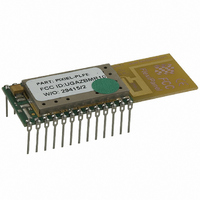PIXLITE-DIL-PLFE Flexipanel, PIXLITE-DIL-PLFE Datasheet - Page 3

PIXLITE-DIL-PLFE
Manufacturer Part Number
PIXLITE-DIL-PLFE
Description
MODULE ZIGBEE SW FAST 24-DIP
Manufacturer
Flexipanel
Series
Pixie™r
Specifications of PIXLITE-DIL-PLFE
Frequency
2.4GHz
Modulation Or Protocol
802.15.4 Zigbee
Power - Output
0dBm
Voltage - Supply
2.1 V ~ 3.6 V
Current - Receiving
25mA
Current - Transmitting
25mA
Data Interface
PCB, Through Hole
Memory Size
32kB ROM, 1536B RAM
Antenna Connector
On-Board, Trace
Operating Temperature
-40°C ~ 85°C
Package / Case
24-DIP Module
Lead Free Status / RoHS Status
Lead free / RoHS Compliant
Applications
-
Sensitivity
-
Data Rate - Maximum
-
Other names
658-1006-5
PIXIE-LITE-PLFE
PIXIE-LITE-PLFE
Communications Standards
The
governs how devices communicate, and so who a
module can interoperate with. The protocol also
specifies how other services work such as error
correction and security.
Some protocols specify ‘profiles’ which define, to
some extent, the nature of the data being
conveyed. This allows for interoperability between
manufacturers.
All protocols introduce some concept of hierarchy
among devices, with a ‘master’ or ‘coordinator’
creating a network, and ‘routers’, ‘end devices’ and
‘slaves’ that participate within it.
The different standards have various licensing
requirements.
compliant for use within an administrative region.
Certification is expensive. FlexiPanel devices are
supplied certified FCC and CE compliant, so this
involves no additional cost to you.
In addition, some standards require registration
with industry bodies, and others require devices to
be allocated a globally unique identification
number.
these bulk costs. Our RF transceivers are pre-
qualified and pre-licensed, with no extra costs.
(Unless you customize them beyond the scope of
their original intended use.)
IEEE 802.15.4
Strengths: Simplicity, low cost.
Weaknesses: Network range, interoperability.
The IEEE 802.15.4 communications protocol is a
low power, low data rate communications protocol.
(Practically speaking, approximately 38.4 kbaud in
FlexiPanel products.)
Communication is single-hop between up to 65K
devices. Messages may be broadcast and any
node can address any other.
Devices are allowed to sleep, but in doing so they
must rely on the central coordinator to cache
messages for them, and their ability to participate
in direct communications with other devices will be
limited.
The protocol is low cost and easy to implement. It
is the protocol of choice if greater complexity is not
required.
Page 3
communications
FlexiPanel’s philosophy is to absorb
2-Feb-07
All devices must be certified as
standard
RF Transceiver Selection Guide DS500-1
(or
protocol)
No profiles are defined by the IEEE 802.15.4
standard. Data is simply transferred as a payload
in a packet which may be up to 127 bytes,
including packet addressing headers.
Each IEEE 802.15.4 device must be assigned a
unique MAC address.
from FlexiPanel are pre-assigned MAC addresses.
In some instances it is not possible to store a MAC
address on the product when shipped and you will
need to request an allocation of MAC addresses
from us.
ZigBee
Strengths: Network range, low power, interoperability.
Weaknesses: Complexity, evolutionary nature.
ZigBee extends the IEEE 802.15.4 protocol to
multi-hop (‘mesh’) communications. This adds to
the addressing header load, but considerably
extends the range of the network by allowing
messages to be forwarded on behalf of other
devices.
Devices may sleep, but if they do, they cannot
forward messages on behalf of other devices. The
availability
however, provide the possibility of an extensive
network where most devices may be battery
powered for several years, if not for the shelf life of
the battery.
In order to implement multi-hop message routing
and to devolve decision making, an underlying tree
structure is defined by a Stack Profile. General
message routing is not restricted by the tree
structure. However, the Stack Profile does define
rigid quantities such as the number of children a
parent device may have, and how many hops a
device is allowed not be from the coordinator.
ZigBee devices employing different Stack Profiles
are not mutually compatible.
The ZigBee Alliance, which defines the ZigBee
Specification, emphasizes interoperability between
manufacturers. Public profiles are defined in detail
through industry-wide consensus.
advantage that it encourages an official standard,
but these standards sometimes prove slow to
come to fruition and thus become rather evolving
standards.
‘Private’
manufacturers, are permitted within the ZigBee
specification, at the cost of registering those
profiles
with
profiles,
of
© FlexiPanel Ltd
mains-powered
the
defined
ZigBee
IEEE 802.15.4 products
by
routers
Alliance
www.FlexiPanel.com
This has the
individual
does,
and






















